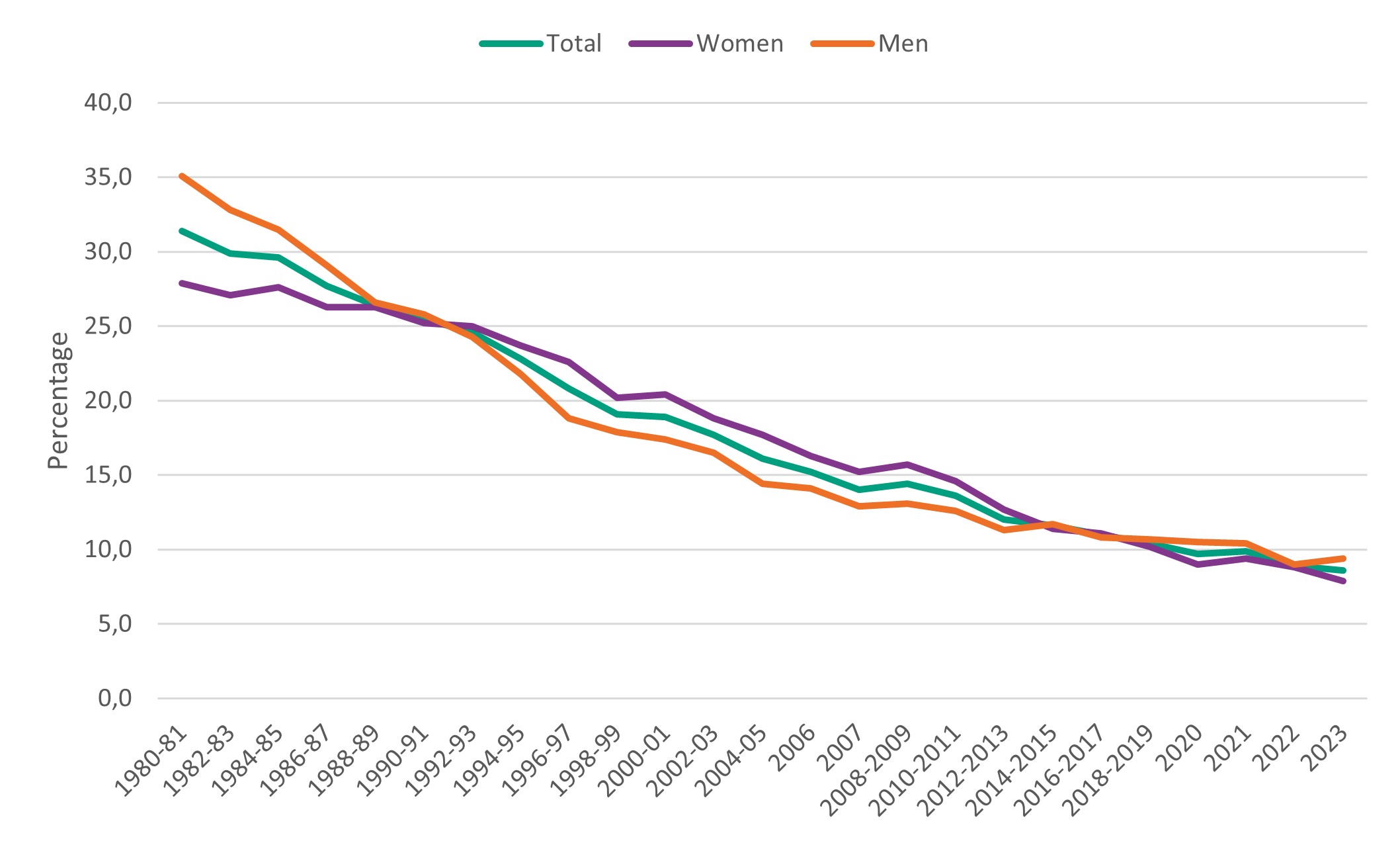Towards a smoke-free Sweden
Daily cigarette smoking has decreased in Sweden since the 1980s. This decrease coincides with the broad tobacco prevention efforts that have been carried out during the same period.
Sweden recognized the risks of tobacco smoking early on, and the first national measures were introduced in the 1960s. The tobacco prevention work in Sweden has:
- Reduced the availability of tobacco products
- Decreased the demand for and social acceptance of smoking cigarettes
- Increased access to smoking cessation programs.
The work has also been long-term and collaborative, involving multiple actors at the international, national, regional and local levels. Examples of tobacco prevention measures that have been implemented include bans on tobacco advertising, tax regulation, age limits, and the introduction of smoke-free environments, both indoors and in certain outdoor areas.
Smoking has decreased in line with tobacco prevention efforts
The proportion of women and men who smoke cigarettes daily has continuously decreased and coincides with the tobacco prevention measures introduced over time.
Figure 1. Proportion of men and women who smoke cigarettes daily over time, from the 1980s onwards. Source: Statistics Sweden (SCB), Surveys of Living Conditions (ULF).

Some important international and national tobacco prevention measures
- 1964 The National Board of Medicines (predecessor of the National Board of Health and Welfare) is tasked with annually informing the public about the health risks of tobacco smoking.
- 1977 Act on warning labels and content declarations on tobacco products is introduced.
- 1979 Act on the marketing of tobacco and alcohol is introduced.
- 1993 The Tobacco Act on smoke-free environments is adopted and includes, among other things, childcare, public premises and transport.
- 1994 Smoke-free schoolyards are introduced in the Tobacco Act.
- 1995 Act on tobacco taxation comes into effect.
- 1997 The 18-year limit for buying tobacco products is introduced in the Tobacco Act.
- 2001 The EU adopts a directive on the manufacture, presentation, and sale of tobacco products.
- 2002 Health warnings and marketing regulations are introduced in the Tobacco Act.
- 2002 Smoking is only allowed in designated smoking areas in restaurants and other service establishments, as introduced in the Tobacco Act.
- 2003 The Swedish Parliament decides on an overarching goal for tobacco policy to reduce tobacco use.
- 2005 Indoor smoking bans in service establishments are introduced in the Tobacco Act.
- 2005 The WHO Framework Convention on Tobacco Control is ratified.
- 2005 Marketing bans, sponsorship, and outdoor advertising are introduced in the Tobacco Act.
- 2011 National ANDT-strategy (2011-2015) is adopted.
- 2015 The goal of a smoke-free Sweden by 2025 is adopted.
- 2016 The EU Tobacco Products Directive (TPD) is implemented.
- 2016 The ANDT-strategy is renewed (2016-2020).
- 2017 The Act on e-cigarettes is introduced.
- 2017/18 The Act on tobacco and similar products is adopted, which includes additional smoke-free outdoor environments and a licensing requirement for selling tobacco.
- 2022 The ANDTG-strategy is renewed (2022-2025) and includes nicotine products (also gambling).
- 2022 Act on tobacco-free nicotine products is enacted.
Challenges in tobacco and nicotine prevention efforts
In Sweden, the use of snus has remained relatively unchanged over time. However, the use of nicotine snus (nicotine pouches) and e-cigarettes has increased significantly among young people in recent years. At the same time, there is an increase in the proportion of young people who smoke cigarettes. Research shows that using e-cigarettes or snus can increase the risk of onset of cigarette smoking.
A challenge in reaching the goal of good and equal health in the entire Swedish population is the large socio-economic differences in smoking. The total tobacco and nicotine use is still relatively high even though daily smoking has decreased. The proportion of the population who smoke cigarettes occasionally is also as large as those who smoke daily.
Tobacco prevention efforts need to become nicotine prevention efforts
To reduce the use of any tobacco and nicotine product, we need to work on reducing the use of all products. Therefore, nicotine products need to be included in future tobacco prevention efforts.
An effective tool in tobacco and nicotine prevention work is protective regulation, and today, regulations differ between products. A regulation of tobacco and nicotine products that is more similar to the current protective legislation for cigarettes would increase the protection of children and young people and create better conditions for a good and equal health.
